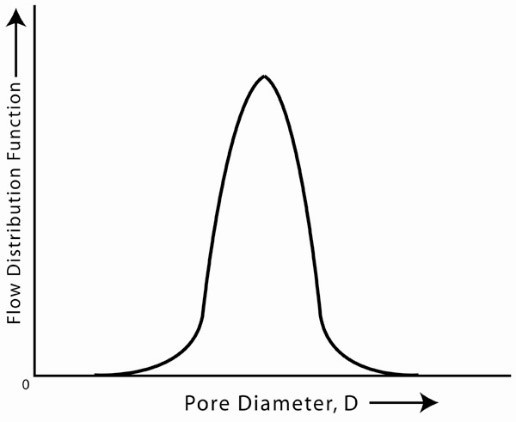
Porous Materials Inc Products - Porosimeters
Capillary Condensation Flow Porometer
The PMI Capillary Condensation Flow Porometer has the unique ability to measure gas permeability and flow rate distribution in addition to measuring pore diameter of nanopore samples without using any toxic materials or extreme pressures and temperatures. No other instrument has such capabilities. It is utilized for characterization of porous membranes used in many industries such as biotech, pharmaceutical, filtration, food and environmental without any fear of harmful effects of high pressures and extreme temperatures on samples. Fragile samples with small pores can be easily evaluated by this technique..




Feature
- Fully automated, simple to use & very little operator involvement
- Highly reproducible & accurate
- Pressure required is very small.
- Normally liquid nitrogen temperatures are not required
- A wide variety of samples can be investigated

Principle
-
At a given temperature, a vapor at a pressure less than the pressure, Po, of vapor in equilibrium with its liquid can condense in pores of a material. Kelvin equation gives the diameter of the pore in which condensation can occur at the relative vapor pressure, (P/ Po).
- At the lowest relative vapor pressure, (P/ Po), condensation occurs in the smallest pore. On increase of relative vapor pressure condensation occurs in larger pores.
ln (P/ Po) = - [ (4 g V CosQ) / (D R T)]
where g: surface tension of condensed liquid.
V: molar volume of condensed liquid.
Q: contact angle of the liquid with the pore surface.
D: pore diameter,
R: gas constant.
T: absolute test temperature.

 The instrument is maintained at the desired temperature. Vapor is introduced in to the sample chamber of known volume. The vapor pressure is monitored until the system comes to equilibrium. From the final pressure, the diameters of pores in which condensation occurs are computed. A small amount of vapor is added to one side of the sample in the sample chamber so as to raise the pressure on that side by about 10 %. The decay of pressure is monitored as a function of time. Gas flow rates through the pores of the sample which do not contain condensed liquid at the maintained pressure of the vapor are computed from the time rate of pressure change. From repeated determination of flow rates at a number of vapor pressures, the flow rate distribution is computed.
The instrument is maintained at the desired temperature. Vapor is introduced in to the sample chamber of known volume. The vapor pressure is monitored until the system comes to equilibrium. From the final pressure, the diameters of pores in which condensation occurs are computed. A small amount of vapor is added to one side of the sample in the sample chamber so as to raise the pressure on that side by about 10 %. The decay of pressure is monitored as a function of time. Gas flow rates through the pores of the sample which do not contain condensed liquid at the maintained pressure of the vapor are computed from the time rate of pressure change. From repeated determination of flow rates at a number of vapor pressures, the flow rate distribution is computed.
Function
-
The PMI Capillary Condensation Flow Porometer has the unique ability to measure gas permeability and flow rate distribution in addition to measuring pore diameter of nanopore samples without using any toxic materials or extreme pressures and temperatures. No other instrument has such capabilities. It is utilized for characterization of porous membranes used in many industries such as:
- Biotechnology & Healthcare
- Pharmaceuticals
- Filtration: UF、NF
- Food & Beverage
- Environmental without any fear of harmful effects of high pressures and extreme temperatures on samples.
Fragile samples with small pores can be easily evaluated by this technique.
| Maximum pore size |
|
| Minimum pore size |
|
| Testing Pressure |
|
| Pressure Gauge |
|
| Sample Size |
|
Data
✓ Porometry Text and Graph Report of Single data
✓ Multi Reports:
up to 10 data sets simultaneously
✓ Data Analysis:
Pore size and Distribution, Mean Pore Size, Gas Permeability
✓ Data Output:
Raw Text、Table Delimited、Excel (Graph Analysis Inclusive)

